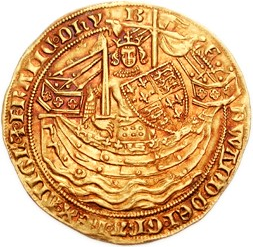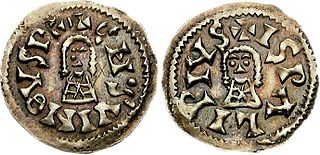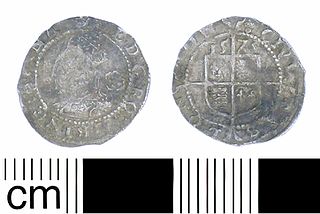This article traces the history of the English penny from 1066 to 1154.
The history of the English penny from 1603 to 1707 covers the period of the House of Stuart, up to the Acts of Union of 1707 which brought about the Union of the Kingdom of England with the Kingdom of Scotland.

The British pre-decimal halfpenny coin, usually simply known as a ha'penny, historically occasionally also as the obol, was a unit of currency that equalled half of a penny or 1⁄480 of a pound sterling. Originally the halfpenny was minted in copper, but after 1860 it was minted in bronze. It ceased to be legal tender in 1969, in the run-up to decimalisation. The halfpenny featured two different designs on its reverse during its years in circulation. From 1672 until 1936 the image of Britannia appeared on the reverse, and from 1937 onwards the image of the Golden Hind appeared. Like all British coinage, it bore the portrait of the monarch on the obverse.

The British threepence (3d) coin, usually simply known as a threepence, thruppence, or thruppenny bit, was a unit of currency equaling one eightieth of a pound sterling, or three old pence sterling. It was used in the United Kingdom, and earlier in Great Britain and England. Similar denominations were later used throughout the British Empire, notably in Australia, New Zealand, and South Africa.

The Triple Unite, valued at sixty shillings, 60/- or three pounds, was the highest English denomination to be produced in the era of the hammered coinage. It was only produced during the English Civil War, at King Charles I's mints at Oxford and, rarely, at Shrewsbury in 1642. It weighed 421 grains.
The British Five Guinea coin was a machine-struck currency produced from 1668–1753. It was a gold coin 37 millimetres in diameter and weighing between 41 and 42 grams. Although the coin is now known as the "five guinea" piece, during the 17th and 18th centuries it was also known as a five-pound piece, as during the reign of Charles II a guinea was worth twenty shillings — until its value was fixed at twenty-one shillings by a Royal Proclamation in 1717 the value fluctuated rather in the way that bullion coins do today.

What is nowadays known as the Two Guineas coin was first minted in 1664, in England, when it had a nominal value of forty shillings and it was known as a forty-shilling piece, then it was later called a double-guinea or two guinea piece, worth forty-two shillings after the Proclamation of 1717 finally settled the value of a guinea. The term "guinea" indicates the source of the gold used to strike the coin, i.e. from west Africa. For most of its period of production the coin weighed 16.7 - 16.8 grams and was 31-32 millimetres in diameter, although the coins of Charles II were about 0.1 grams lighter and 1 millimetre smaller.

The guinea was a coin of approximately one quarter ounce of gold that was minted in Great Britain between 1663 and 1814. The name came from the Guinea region in West Africa, where much of the gold used to make the coins originated. It was the first English machine-struck gold coin, originally worth one pound sterling, equal to twenty shillings, but rises in the price of gold relative to silver caused the value of the guinea to increase, at times to as high as thirty shillings. From 1717 to 1816, its value was officially fixed at twenty-one shillings.
The half guinea gold coin of the Kingdom of England and later of Great Britain was first produced in 1669, some years after the Guinea entered circulation. It was officially eliminated in the Great Recoinage of 1816, although, like the guinea, it was used in quoting prices until decimalisation.

The half laurel was a coin of the Kingdom of England minted between 1619 and 1625, with a value of ten shillings.

The Unite was the second English gold coin with a value of twenty shillings or one pound first produced during the reign of King James I. It was named after the legends on the coin indicating the king's intention of uniting his two kingdoms of England and Scotland. The unite was valued at twenty shillings until 1612 when the increase in the value of gold throughout Europe caused it to be raised to twenty-two shillings. The coin was produced during James I's second coinage (1604–1619), and it was replaced in the third coinage by the Laurel worth twenty shillings. All the coins were produced at the Tower Mint in London.

The dime, in United States usage, is a ten-cent coin, one tenth of a United States dollar, labeled formally as "one dime". The denomination was first authorized by the Coinage Act of 1792. The dime is the smallest in diameter and is the thinnest of all U.S. coins currently minted for circulation, being .705 inch (17.91 mm) in diameter and .053 inch (1.35 mm) in thickness. The obverse of the current dime depicts the profile of President Franklin D. Roosevelt and the reverse boasts an olive branch, a torch, and an oak branch, from left to right respectively. As of 2011, the dime coin cost 5.65 cents to produce.

The British halfpenny coin was worth 1/480th of a pound sterling. At first in its 700-year history it was made from silver but as the value of silver increased, the coin was made from base metals. It was finally abandoned in 1969 as part of the process of decimalising the British currency. "Halfpenny", colloquially written ha'penny, was pronounced HAY-pə-nee; "1 ½d" was spoken as a penny ha'penny or three ha'pence.
The threepence or threepenny bit was a denomination of currency used by various jurisdictions in England, Ireland, Scotland and Wales, valued at 1/80 of a pound or ¼ of a shilling until decimalisation of the pound sterling and Irish pound in 1971. It was also used in some parts of the British Empire, notably Australia, New Zealand and South Africa.

The coinage of the Visigoths was minted in Gaul and Hispania during the early middle ages, between the fifth century and approximately 710.

The pre-decimal penny (1d) was a coin worth 1/240 of a pound sterling. Its symbol was d, from the Roman denarius. It was a continuation of the earlier English penny, and in Scotland it had the same monetary value as one pre-1707 Scottish shilling. The penny was originally minted in silver, but from the late 18th century it was minted in copper, and then after 1860 in bronze.
The English shilling was a silver coin of the Kingdom of England, when first introduced known as the testoon. It remained in circulation until it became the British shilling as the result of the Union of England and Scotland to form the Kingdom of Great Britain in 1707.

The English three halfpence, a silver coin worth 1 1⁄2d, was introduced in Elizabeth I of England's third and fourth coinages (1561–1582) as part of a plan to produce large quantities of coins of varying denominations and high silver content. The obverse shows a left-facing bust of the queen, with a rose behind her, with the legend E D G ROSA SINE SPINA – Elizabeth by the grace of God a rose without a thorn – while the reverse shows the royal arms with the date above the arms and a mintmark at the beginning of the legend CIVITAS LONDON – City of London, the Tower Mint.

A farthing was a coin of the Kingdom of England worth one quarter of a penny, 1⁄960 of a pound sterling. Such coins were first minted in England in silver in the 13th century, and continued to be used until the Kingdom of England was merged into the new Kingdom of Great Britain in 1707.

















